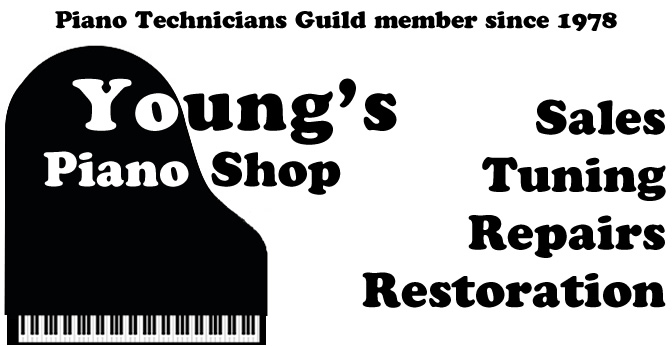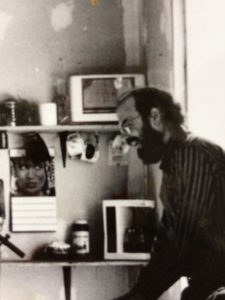Frequently Asked Questions
Each of these questions has actually been asked of me. If you have a question that you don’t see answered here, by all means contact me. I don’t have all the answers, but am willing to take whatever stab at your question that my experience will support. I will not hesitate to tell you if your question is out of my range, and will gladly try to refer you to another source.
Most manufacturers recommend tuning your piano at least twice yearly. Semi-annual servicing of your piano is my best recommendation to insure its long life, and maintain its performance quality. As a compromise, many of my clients (and their pianos) do quite well with my minimum recommendation of once a year. Sticking with regular service, either once or twice a year, is your best insurance. Concert pianos are generally tuned, and otherwise prepared for every performance. Not all pianos behave the same way and not all environments treat your instrument with the same degree of TLC. Keeping the temperature and humidity at constant, moderate levels will help tuning stability. Use of a piano climate control system will help even out humidity levels.
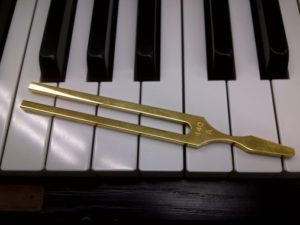 440 Cycles per second is the conventional frequency assigned to "A" of the piano scale. This is what you hear when you play "A" natural above middle "C".--That is if your piano has been recently tuned to match this standard. When a piano is left untuned and neglected, it will not only begin to sound sour within its own relative pitch, but will fall flat from the standard A=440cps. In this sad situation, when one plays "A" above middle "C" they are likely to hear "A flat" or an even lower note. This not only contradicts the rest of the musical world but can be a two fold detriment to piano enjoyment. First, it compromises the player's ability to develop a good sense of correct pitch, and second, the piano itself was designed to perform at its tonal best when proper string tension is maintained.
440 Cycles per second is the conventional frequency assigned to "A" of the piano scale. This is what you hear when you play "A" natural above middle "C".--That is if your piano has been recently tuned to match this standard. When a piano is left untuned and neglected, it will not only begin to sound sour within its own relative pitch, but will fall flat from the standard A=440cps. In this sad situation, when one plays "A" above middle "C" they are likely to hear "A flat" or an even lower note. This not only contradicts the rest of the musical world but can be a two fold detriment to piano enjoyment. First, it compromises the player's ability to develop a good sense of correct pitch, and second, the piano itself was designed to perform at its tonal best when proper string tension is maintained.
Pitch raising is the job the piano tuner must undertake in order to restore the neglected piano to the correct string tension. It generally involves several rough tunings prior to attempting any fine tuning. The recently "pitch raised" piano will require time and several more fine tunings before normal tuning stability is fully restored.
Certainly place your piano where you will use and enjoy it most. Because of the benefits of stable temperature and humidity, some basic guidelines apply: An inside wall is best. Avoid sources of heat such as warm air vents, base board or other radiators, or wood burning stoves. Avoid direct sunlight which can harm your piano's exterior finish.
Many homes are simply not designed to include the "ideal" piano location and compromises must be made. An outside wall can be used if necessary, but try to stay away from windows, or heat sources. A climate control system will help maintain an even environment to protect your piano from damage. Dry heat is the number one killer of pianos.
If the piano needs no repair, and is tuned regularly, it takes me about 45 minutes to tune all of the 230 odd strings. This is after doing it every day for over thirty years. If the piano requires pitch raising, an additional hour may be required, and the tuning may not hold as well.
The short answer is that a piano is tuned by adjusting the tension of the 230 odd strings that are stretched across its frame so that all the notes will play harmoniously at their assigned frequencies.
More specifically, there are two main techniques:
1) Tuning by ear is done by carefully listening to and adjusting the interference vibrations between the coincident partials of intervals within the musical scale. It sounds complicated, but it is really a matter of adjusting the string tension so that all of the intervals (two notes played together) "beat" in a pleasing, even progression, slower in the bass and faster in the treble.
2) Tuning with a visual aid is accomplished by carefully adjusting string tension so that the vibrational frequencies match an ideal configuration indicated by an external electronic aid or scope. Some visual aids are simple, and others as complex as modern computer technology.
Experience has proven that excellent results can be achieved employing either method. In either case there is no substitute for the care and experience of the technician. Common to both methods are techniques for settling the string and tuning pin to help preserve tuning stability, and strategy such as "rough" tuning a few times to get a very flat piano close to pitch before fine tuning.
For a piano that is in good condition, the main reason for tuning decay is the effect of relative humidity on wood. As the wooden components of your piano gain or lose moisture with the climatic change of seasons, these parts ever-so-slightly change size. It's the same reason that a door in your home may stick in the summer, but swing freely in the winter. No part of the piano is affected more by this change than the soundboard, and the soundboard is bearing an indirect "downward" force from the strings. When the soundboard looses moisture, its crown (or curved profile) relaxes, decreasing the string tension, and the piano, especially in the middle range, falls flat. When moisture is gained in the summer, the piano goes sharp for the opposite reason. Controlling the seasonal fluctuation will greatly improve tuning stability.
Yes. It's because of the regular service that your piano sounds great. That's the way it should be when a piano has been faithfully maintained, kept in a moderate, even environment, and has been given time to settle in. Your piano tuner still has to listen carefully to each string, and probably adjust the tension of 90% of them. It is this regular "clean-up" tuning that prevents the need for major, unsettling adjustment. It's a bit like weeding a flower garden; if it is done regularly, the tiny weeds are hardly noticed. If the garden is neglected, the weeds take over.
Giving the key a firm "test blow" is an important step towards settling the string and thus allowing better tuning stability. The tuner strikes the key with sufficient force to better equalize the string tension across the few bearing points of the string's length. Combine this pounding with proper tuning lever technique, and the piano will hold on to it's tune. If the test blows are omitted, the first player to apply much force to the keys could knock the piano out of tune.
Genuine Ivory: Ordinary residue that builds up from normal playing can usually be removed by firm wiping with a damp cloth. A mild dish soap on the cloth will help on stubborn areas. Follow with a dry cloth or paper towel. A naphtha (ordinary lighter fluid) dampened paper towel will remove crayon, and most of the adhesive residues left behind if your keys were ever "labeled". Cigarette burns and certain inks, will penetrate into the sub-surface of the ivory, and can only be removed by scraping, sanding, and re-polishing, if you're lucky.
Simulated Ivory, Plastic, and most modern keytop materials: Use the same procedure as for genuine ivory, but be careful about using solvents that could etch or partially dissolve the material. This is usually not a problem, but it is wise to do a small test patch at the back of a key before you start work on middle C.
WARNING: I know it sounds funny, but on older pianos be careful not to rub the black color off of the sharps by scrubbing too hard! I've seen this many times.
I usually recommend using a solvent based glue for this purpose. Examples are: contact cement, rubber cement, "duco" cement, epoxy, and "crazy" glue. Water based glues such as "elmer's", or "tightbond" tend to cause genuine ivory to curl up as it is absorbed into it. Unless the piano is dismantled, the clamping options are next to none, and most of the glues I have recommended need no clamping.
Be sure the surfaces are clean. Scrape off any old glue that may be on the pieces. Wipe up any excess glue. If all else fails, follow the directions on the glue container. When possible, be sure to put the loose ivories back on exactly the key they came off of. Careful inspection of the glue surfaces and particularly the back edge of the ivory piece will lend clues to their placement.
If a sharp (black key) has come off, this is when you use the elmer's or tightbond type of wood glue. Put an even layer of glue on the bottom of the sharp, and carefully align it where it belongs. Wipe off the excess glue. It should not require clamping, which can cause it to slip out of alignment anyway.
Genuine ivory is distinguished in two main ways: First, it is almost always divided into two parts, with a seam between the head piece and the tail piece. Most synthetic materials are one piece with no seam. Second, upon close inspection, real ivory always shows at least a faint grain pattern similar to the grain pattern in wood.
I think that children should be encouraged to touch and play the piano at any age. Even discordant fingering of the keys opens the way for children to experience the fun of making music. The piano is designed to handle any blow that can be dealt with a finger. The rule I stressed with my children, was to use "fingers only" on the keyboard--and clean fingers at that. No fists, no xylophonesticks, no little cars, action figures etc. It is very difficult to damage a piano ivory using just one's fingers, but look at all the pianos with chipped keys.
An open jar of water kept in the bottom of an upright piano is the old fashioned method of adding moisture to the piano during the dry winter months. It won't hurt, but it's not very effective and there is no control over it as in a real climate control system. If you haven't been convinced to install such a system, investing in a room humidifier would be a more effective compromise than relying on a jar of water.
A properly installed climate control system will help maintain an even amount of humidity in your piano's immediate environment. Most systems include five main components, a humidifier, a dehumidifier, a humidistat to control them, and for convenience, a low water warning light to eliminate the need of checking the water level, and an "easy fill tube" to make maintenance a snap. Click here for more information.
Okay, no one has really asked this question, but there are a few simple things you can do to make the job of servicing your piano easier and more efficient for both you and your piano technician.
1. Clear off the top of your piano before the technician arrives. This has to be done in order to open up the piano cabinet for service.
2. Provide a "quiet time" in your house so the tuner can do his or her very best work for you. Television, music playing, vacuum cleaning, or other noise can be distracting to the piano tuner, so please try to minimize the volume by turning things off or possibly closing some interior doors.
3. Provide adequate lighting. Most piano technicians carry a flashlight for close inspection of specific problems, but good general lighting will help the entire job go more quickly. Very often the piano lamp that you may keep on the top of your piano cannot be used, because once the piano is open, there is almost nowhere to set it. Consider bringing a floor lamp close to the piano if there is no other available light source.
4. Keep a list of any mechanical or acoustic problems or questions that you may have. It's very helpful when the piano owner can say...."E flat below middle C seems to not be repeating very well" instead of "One of the keys was sticking last month, I'm sure you'll find it." The technician may or may not find it, but do you really want to pay for the time they may have spend hunting for it?
5. Plan ahead. Most of your piano tuner's schedule is probably booked up for at least a month or so. If you know that you'll be wanting your piano in its best tune for a specific recital or gathering (like a wedding), call the piano tuner as soon as you know the date, they are prepared to schedule your service call a long time in advance.
Of course I can, they have scales all over them. (Truly a frequently asked question).
This refers to adjustments made to the hundreds of moving parts in the action, and leads to faster repetition, and across the board uniformity. It also provides an opportunity, at least to some degree, to customize the touch or feel of the action.
Voicing is the process of adjusting a piano's tone quality. Just as tuning is the adjustment of a note's pitch, voicing is the adjustment of a note's timbre, or sound quality. A piano voice can have a range of acceptable quality, from "mellow" to "bright". (the unpleasant extremes being: "dull" and "shrill") Although there are many important prerequisites, most voicing is accomplished by adjusting the density of the hammer felt, through needling to soften or bolstering with various hardening solutions. Ask your technician what might be done to improve your piano's voice.
People often wonder if something is missing or has been removed from their piano because there are no dampers for the 18 or so highest notes. Pianos are actually designed to perform without the need for the upper dampers since the shorter strings in this high treble section have very little in the way of natural sustain. Additionally, the open, undamped strings of the high treble add tone color to the entire piano range by vibrating sympathetically when lower chords are struck.
Three basic things: Design, Materials, and Workmanship. Effectively combined these basics will produce an instrument of superior tone, touch and beauty. Cut corners in any area, and quality suffers.
Design: Was the piano designed to produce optimal tone, respond fluidly to the touch of the pianist, and have a pleasing appearance, or was it designed to be quickly and cheaply mass produced?
Materials: Does the manufacturer call for the best performing, most durable materials available, or the least costly alternative? The range of quality in this area alone is extensive. Natural materials such as wood and felt must be specially selected to meet the demands of the piano design.
Workmanship: Did men and women labor for months to carefully hand craft the piano, paying strict attention to detail, or was it quickly and carelessly assembled, leaving the details to be attended to later by the service technician? Quality pianos usually arrive at the dealer's showroom in relatively good tune and regulation.
Since I can't put your piano on a scale, I'll give some general averages. The smallest spinet may weigh as little as 300 or so pounds (about 136 kilos). Average studio uprights range about 400 to 500 lbs. (180-230 K) with full uprights topping out around 600 lbs. (275 K). Small and medium sized grands compare to upright piano weights, and concert grands may weigh well over 1000 lbs. (about 450 K). Click to see a chart of Steinway Grand weights and sizes.
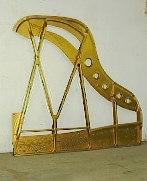 The single heaviest component within your piano is the cast iron plate. Pictured here is the plate, sometimes called the harp, from a small grand piano. It has been temporarily removed to allow for replacement of this piano's pin block. Along with other general structural elements, this plate bears the incredible tension that over 200 tightly stretched music wires exert on it. On average, each string in the piano is stretched to a tension equaling about 165 pounds (75 Kilos). Multiply by the number of strings, and you'll find that the structure must be built to withstand close to 20 tons (18,000 K) of stress. With all this tension, a piano has to be heavily constructed to survive.
The single heaviest component within your piano is the cast iron plate. Pictured here is the plate, sometimes called the harp, from a small grand piano. It has been temporarily removed to allow for replacement of this piano's pin block. Along with other general structural elements, this plate bears the incredible tension that over 200 tightly stretched music wires exert on it. On average, each string in the piano is stretched to a tension equaling about 165 pounds (75 Kilos). Multiply by the number of strings, and you'll find that the structure must be built to withstand close to 20 tons (18,000 K) of stress. With all this tension, a piano has to be heavily constructed to survive.
In addition to this massive chunk of cast iron, a piano is loaded with solid hardwood, and other metal parts including steel tuning pins and lead key weights.
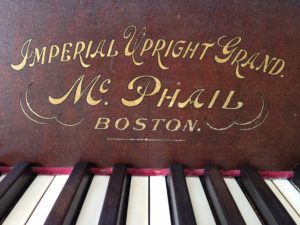 Pianos come in two basic styles: Upright (vertical), and Grand (horizontal). Some older vertical pianos bear the label "Upright Grand" or "Cabinet Grand" or even "Boudoir Grand". All of these misleading labels are basically sales hype from days gone by. The basic upright piano has all of the same features as these "Grands". However, although it has nothing to do with true grand pianos, instruments with this label were usually the manufacturer's deluxe, larger model.
Pianos come in two basic styles: Upright (vertical), and Grand (horizontal). Some older vertical pianos bear the label "Upright Grand" or "Cabinet Grand" or even "Boudoir Grand". All of these misleading labels are basically sales hype from days gone by. The basic upright piano has all of the same features as these "Grands". However, although it has nothing to do with true grand pianos, instruments with this label were usually the manufacturer's deluxe, larger model.
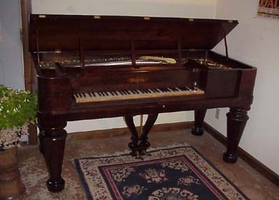 The square style of grand piano is a relic of a bygone age. One still finds them here and there, and in fact, I service several on a regular basis. These pianos have been out of production and essentially obsolete since about the turn of the century--that would be 1900. Many fine piano manufacturers produced a square piano including Steinway. In appearance, the square piano is really rectangular, with the keyboard slightly to the left of center on the front long side. The four massive legs distinguish this type of piano from any other. Cabinets were often veneered in rosewood and very ornate. The long bass strings of this type of piano run parallel to the front of the cabinet, not front-to-back as in traditional grands. These pianos are obsolete for some very good reasons. The generally flat (vs. crowned) soundboard, combined often with fewer strings per note made for a rather weak tone. With a simpler action mechanism, the piano key must be returned to its "top" rest position before it will repeat (modern grands will repeat at the slightest flutter of the key) usually leading to a stiffer overall feel. On the other hand, a square piano is a beautiful piece of history and can be cherished for that reason alone. I do caution people that these antiques should be appreciated for their historical significance, and if one is looking for a durable piano that meets modern standards they should set their sights on a good vertical, or traditional grand piano. The Chickering piano pictured here is for sale and can be seen in greater detail on my "Pianos for Sale" page.
The square style of grand piano is a relic of a bygone age. One still finds them here and there, and in fact, I service several on a regular basis. These pianos have been out of production and essentially obsolete since about the turn of the century--that would be 1900. Many fine piano manufacturers produced a square piano including Steinway. In appearance, the square piano is really rectangular, with the keyboard slightly to the left of center on the front long side. The four massive legs distinguish this type of piano from any other. Cabinets were often veneered in rosewood and very ornate. The long bass strings of this type of piano run parallel to the front of the cabinet, not front-to-back as in traditional grands. These pianos are obsolete for some very good reasons. The generally flat (vs. crowned) soundboard, combined often with fewer strings per note made for a rather weak tone. With a simpler action mechanism, the piano key must be returned to its "top" rest position before it will repeat (modern grands will repeat at the slightest flutter of the key) usually leading to a stiffer overall feel. On the other hand, a square piano is a beautiful piece of history and can be cherished for that reason alone. I do caution people that these antiques should be appreciated for their historical significance, and if one is looking for a durable piano that meets modern standards they should set their sights on a good vertical, or traditional grand piano. The Chickering piano pictured here is for sale and can be seen in greater detail on my "Pianos for Sale" page.
The sustain pedal
On virtually all pianos, the right pedal pushes the dampers away from the strings. This allows a note to sustain its tone even if the key is released. Its use adds a particular form of expression and sympathetic resonance to color the music.
The soft pedal
The left pedal, on most all pianos is used to soften the tone and volume of the music. In the upright piano (and a few grands) this is achieved by shortening the blow distance of the hammer; its "at rest" position is moved closer to the strings. In the grand piano the softer affect is the result of shifting the whole piano action laterally just enough so that each hammer strikes only two of its three strings. (One of two in the bass section.) In grand pianos we call this the "shift" or "una corda" pedal
ah...the middle pedal
This is the weird one. Traditionally in grand pianos (as well as some of the best uprights) this is the sostenuto pedal. It allows for selective sustain. If you depress a key, and step on this pedal, that key alone will sustain while the other notes played are stopped by the damper action.
On many pianos the middle pedal activates a bass only sustain, allowing notes to ring long in the lower register, even as the higher notes are damped. Sometimes referred to as the "poor man's sostenuto".
In some upright pianos the middle pedal controls a muting strip of felt that, when engaged, substantially reduces the music volume by dropping into place between the hammers and strings. Or, in place of the felt strip a series of metal tabs drop down to create a "honky tonk" affect. In others, this pedal is completely redundant, and is connected to the same linkage as the soft pedal. In some pianos this middle pedal is entirely for show and only connects to a spring designed to make it look useful! For the average amateur player, a two pedal piano is fine.
In most cases, the older upright or grand piano can be economically restored to good usable condition. Some pianos are worth the extensive rebuilding needed to return them to "like new" condition. A qualified piano technician can advise you regarding what the best route may be for your piano.
In general, worn or broken action parts can be replaced or repaired, the keytops can be replaced with new ones or carefully matched with genuine ivory salvaged from other pianos. The case can be stripped and refinished. The hammers may need to be reshaped and voiced. Worn, buzzing, or "leaky" damper felts can be replaced. If necessary, the piano can be restrung. Most every piano will be improved greatly by thorough regulation. Rebuilding of a piano usually means that all of these steps will be taken, and more, such as installation of a new sound board, bridges, and complete piano action.
A crack in the the piano's soundboard is the inevitable result of the wood shrinking and swelling with the fluctuation of relative humidity as explained under Why does my piano go out of tune?
If the soundboard crack is what I call "active", the symptom will be a buzz or rattle as the piano is played. In most cases, such a crack can be stabilized and "deactivated", and will pose no significant problem. One should always remember to address the cause as well as the symptom by correcting the situation that led to the cracking in the first place. Soundboard cracks can destroy a piano if left unchecked. Cracking results in gradual separation of the board from its supporting ribs. As this separation advances, the soundboard will lose its "crown". A piano soundboard has a curved surface just as the top of a violin is curved. If this crown is lost, the tone of the piano will most likely be permanently devastated. Soundboard replacement can be an option in this case, but is cost prohibitive in all but the most valuable pianos.
Absolutely. Pianos can be junked because of one devastating problem such as a badly broken cast iron plate (see why is my piano so darn heavy?), or because of an overwhelming amount of smaller problems that make restoration economically unfeasible. I am occasionally in the position of having to inform a client that their piano has reached the end of its useful life, and although it is sad to have to do so, I'd rather condemn the piano than bring them false hope and useless expense. When called to do an estimate, I'm expected to be objective, not sentimental.
Many piano parts can be recycled. In the restoration of other pianos I often am able to reuse many parts. In fact I have an extensive collection of good condition parts and am often able to use "original equipment" when restoring an older piano.
I have built clavichords and hammered dulcimers almost entirely from junk piano sources.
Bartolommeo Cristofori, (1655-1731) an Italian instrument maker, is generally credited with inventing the first keyboard stringed instrument in which metal wires were struck with hammers to produce musical tones. The distinguishing feature was the hammer. By percussively striking the music wire, the pianist can vary the force or volume of tone produced, allowing an infinite range of expression in the music. The full name of the piano is Pianoforte, and refers to the instrument's ability to play both loud and soft tones. In the almost 300 years since Cristofori's innovation, thousands of others have made significant contributions to the development of the piano as we know it today. The basic design of the modern piano has changed relatively little in the last 120 years.
OK, I'll admit I'm somewhat biased in my opinion, but no other musical instrument can compare to the piano. The piano has it all! It has percussion, harmony, and dynamics. It sounds great un-accompanied, or can sing out against a full symphony orchestra. Piano study teaches music theory, chord structure, expression and rhythm all in a format that is easy to see and is right at your fingertips. It is the ideal instrument to learn on because it combines so many elements of what makes music the pleasure that it is.
In a word, no. Electronic keyboards certainly have an important place in music, but it is not as a substitute for the piano. The inexpensive models don't even come close to playing or sounding like pianos. The more costly keyboards at best sound like a recording of a piano. There is no substitute for the wooden box. The true tone of a piano is produced by vibrating strings amplified by a spruce soundboard. Electronic sounds are produced by a vibrating paper cone sealed inside a speaker cabinet. A digital piano is a simulated piano.
Silk flowers are pretty to look at, but they are not flowers.
Electronic keyboards are useful when interfaced with computer software for music instruction or composition. The variety of sounds that they can produce are fun to play around with. They're great in a band or combo when you have to set up or tear down equipment night after night; they are great in a dorm room, but not on the professional concert stage, and not for learning to play piano on.
The responsive touch of a real piano is enhanced by the actual rebound of the hammer from the string. This rebound effect not only allows for greater speed of repetition, but also provides the artist with a tactile "feedback" response from the instrument, almost giving the piano a "life" that electronics can't touch.
My other caution regarding electronic keyboards involves durability. When properly cared for, a real "acoustic" piano will last a hundred years or more. I know some would argue with me, but in my experience, most electronic keyboards become obsolete in about ten years or less as far as service is concerned.
The best way is by referral from some you know. Piano teachers, school music teachers, church choir directors, and professional musicians should be able to recommended a good technician. Find out who is servicing your neighbor's piano and if your neighbor is satisfied with the service provided. Membership in the Piano Technicians Guild is a sign that the tuner has passed qualifying exams and has access to a wide range of resources to augment their skills. Some other very competent technicians have not joined the guild. Click here to find the Search Engine of the Piano Technicians Guild.
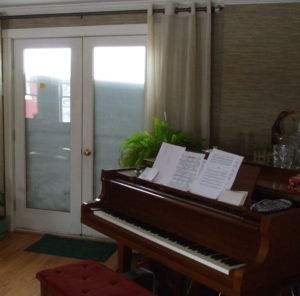
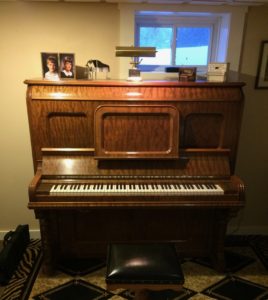
Although I own many pianos at my shop, I have two home pianos for my personal use. One is a restrung Kawai Grand model 500 from 1967, pictured on a snowy day. The other is the mighty Behr Brothers Upright - factory inspected on November 11, 1891. I refinished its burl walnut case in 1979.
It kind of depends on when you start counting. I first picked up a tuning hammer in the fall of 1976 and began exploring on my own. I graduated from a year long Piano Technology trade course in 1978, did my apprentice stint, joined the Guild, and had my first paying Vermont client on August 28th of the same year. So about forty years!
